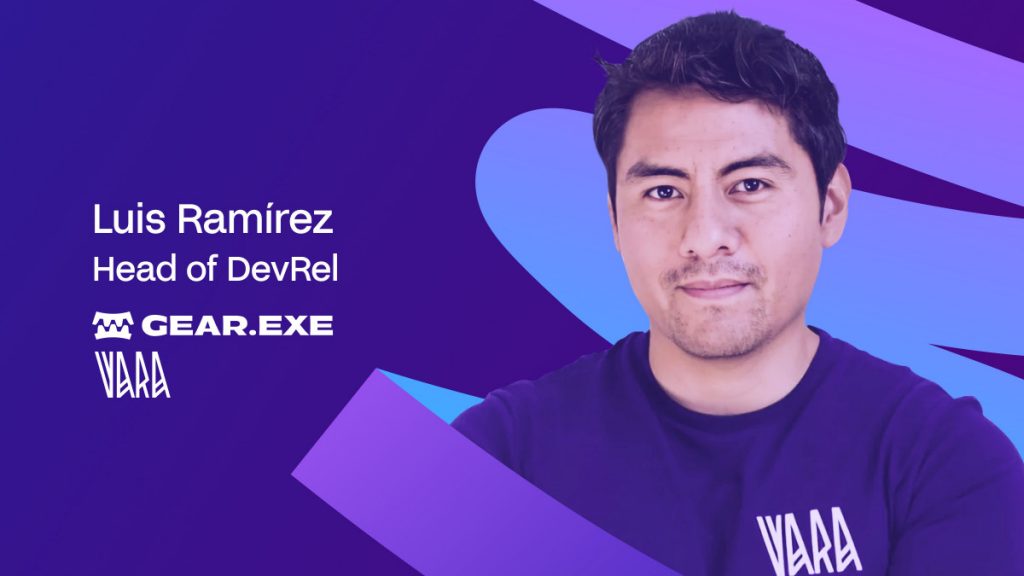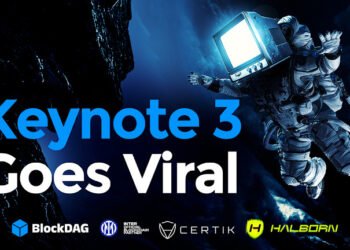

In Temporary
Gear.exe is revolutionizing Web3 scalability and effectivity by providing a decentralized compute community that enhances Ethereum’s efficiency, eliminates fragmentation, and introduces a singular reverse gasoline mannequin to enhance adoption.

Scaling and effectivity are main challenges in Web3, and Gear.exe is tackling them head-on. To be taught extra, we spoke with Luis Ramírez, Head of DevRel at Gear Basis, about how their decentralized compute community is enhancing Ethereum’s efficiency whereas avoiding fragmentation.
On this interview, Luis explains how Gear.exe allows seamless scalability and discusses its distinctive reverse gasoline mannequin. He additionally touches on the way forward for blockchain, AI, and what’s subsequent for Gear.exe.
Are you able to share your journey to Web3?
I’m presently the pinnacle of the World Vast Net Basis, and my background is primarily technical. I’ve been working in IT for 20 years. I began as a developer and based my very own firm 10 years in the past to create numerous merchandise. Like virtually everybody, I started in Web2 as a result of Web3 continues to be comparatively new.
Throughout my journey with my firm, I built-in totally different applied sciences. In 2013, I began accepting Bitcoin as cost for my growth companies, however nothing important occurred again then because it wasn’t the very best time for Bitcoin. Later, in 2017, I started growing good contracts on Ethereum. From that time on, I transitioned to blockchain expertise.
In 2019, a Russian good friend launched me to Rust and blockchain, and later, he invited me to be a part of Gear. I’ve now been working with Gear for 3 and a half years. My background is generally centered on growth, rising developer communities, and strategic initiatives throughout totally different areas the place the Gear Basis has an official presence. Presently, we now have groups within the US, Mexico, Spain, India, China, and different components of the world.
Ethereum has been dealing with rising challenges, corresponding to excessive latency and restricted computational energy. How does Gear.exe tackle these points? How does it examine to Layer 2 options?
Gear.exe is a decentralized compute community, and we deal with fixing Ethereum’s computational challenges. We’re utilizing expertise already confirmed in Vara, corresponding to WebAssembly, the Actor Mannequin, and Persistent Reminiscence. These applied sciences enable us to scale purposes within the Web3 area securely whereas using frameworks and programming languages like Rust.
We transferred this expertise to Gear.exe to unravel Ethereum’s scalability points. Nonetheless, Gear.exe just isn’t a blockchain—it’s a decentralized compute community. This distinction is vital as a result of whereas Layer 2 options resolve scalability points, in addition they introduce fragmentation. Customers typically must create new accounts, which fragments TVL and token balances. Gear.exe prevents this by permitting builders to work together with our community through an API whereas sustaining compatibility with Ethereum infrastructure.
Fragmentation of liquidity and knowledge has been a persistent difficulty for Ethereum. Gear.exe claims to eradicate fragmentation. How does it obtain this whereas sustaining scalability?
Though Gear.exe just isn’t a blockchain, we use some blockchain-based applied sciences. For instance, we validate knowledge, however we don’t retailer person accounts. This implies no extra person knowledge is created, no new accounts are required, and liquidity stays solely inside Ethereum.
Our system solely processes computational requests and returns the outcomes to Ethereum throughout the identical block. Different applied sciences can obtain related outcomes, however typically in several blocks, which introduces delays. Relying on the computation required, we guarantee excessive scalability. Our platform is suitable with WebAssembly, and good contracts are interpreted by a WebAssembly digital machine inside our nodes. This makes our resolution each quick and safe.
Gear.exe makes use of a reverse gasoline mannequin, permitting apps to cowl person charges. How does this work in apply?
In conventional Web3 purposes, customers work together with a frontend however want a pockets and tokens to speak with the blockchain. This requirement generally is a main barrier for adoption.
Gear.exe solves this with a reverse gasoline mannequin. As a substitute of requiring customers to carry tokens for transactions, builders can prepay transaction charges utilizing a system referred to as vouchers. These vouchers are saved within the good contract, and any person interacting with the contract doesn’t have to fret about offering tokens or overlaying gasoline charges. It is a highly effective characteristic that enhances usability and adoption.
Have you ever carried out efficiency benchmarks evaluating Gear.exe-enabled dApps to conventional Ethereum or roll-up-based dApps? If that’s the case, what are the outcomes?
Sure, completely. We have now printed movies and articles detailing our benchmarking outcomes. We in contrast Gear.exe to Ethereum and Layer 2 options like Arbitrum, each its EVM and WebAssembly variations.
In comparison with Ethereum, Gear.exe is roughly 1,000 occasions quicker and considerably cheaper. In comparison with Arbitrum, Gear.exe is about 200 occasions extra cost-efficient. Even Arbitrum’s WebAssembly-compatible implementation—arguably the very best Layer 2 possibility for Ethereum—can not match our efficiency, as we use Rust as a substitute of Solidity and have our personal good contract platform.
Given the continued challenges of excessive charges, community congestion, and centralization dangers in Layer 2 options, do you consider Ethereum will stay the dominant good contract platform, or will various architectures take the lead?
Different platforms like Solana are gaining traction, significantly amongst builders. Nonetheless, lots of the most well-known use circumstances revolve round meme cash, since Web3 customers primarily deal with monetary features. Whereas expertise is essential, person habits additionally performs a key position in adoption.
That mentioned, Ethereum nonetheless has the most important developer group. We goal to draw builders by means of Gear.exe whereas remaining blockchain-agnostic. Presently, Gear.exe is built-in with Ethereum’s Holesky testnet, however sooner or later, we plan to develop help for extra networks.
Gear.exe leverages WebAssembly for effectivity. Do you see WebAssembly-based execution environments changing into the business commonplace for next-generation blockchain platforms?
Sure, WebAssembly has considerably improved digital machine efficiency. Early good contract platforms relied on Ethereum’s EVM, however the transition to WebAssembly began with Gavin Wooden when he was growing Polkadot. Our CEO, Nikolay, was concerned in that shift from EVM to WebAssembly.
Right this moment, WebAssembly has confirmed itself when it comes to each effectivity and safety. A number of blockchain platforms, together with Close to and a few Ethereum Layer 2 options like Arbitrum, are adopting WebAssembly. This means a rising development in the direction of WebAssembly-based execution environments.
With the rising overlap between blockchain and AI, do you see Ethereum’s future tied to AI-driven good contracts and decentralized compute networks?
Completely. Though Ethereum is dealing with inner challenges inside its group, it stays the most important ecosystem for builders. The intersection of AI and blockchain is already being explored, with a number of options constructed on Ethereum.
Presently, AI computations will not be carried out immediately on Ethereum on account of excessive prices. As a substitute, many options depend on off-chain processing. With Gear.exe, decentralized AI execution turns into possible, making AI-driven good contracts extra sensible. AI brokers are gaining traction, and this development will proceed rising.
Will improvements like Gear.exe’s reverse gasoline mannequin be sufficient to make Web3 as seamless as Web2, or are greater infrastructural adjustments wanted?
I consider it’s not sufficient by itself. The reverse gasoline mannequin is a crucial step in making Web3 extra accessible, particularly for Web2 builders. Nonetheless, the Web3 ecosystem additionally wants new enterprise fashions that bridge Web2 and Web3. Adoption isn’t nearly infrastructure—it’s additionally about creating viable enterprise incentives.
Are you able to share the roadmap for Gear.exe?
Presently, Gear.exe is working on the Holesky testnet. The staff is engaged on enhancements to boost compatibility, significantly with the Vara community’s good contracts.
Our aim is to allow seamless migration of Vara good contracts to Gear.exe with none modifications. It is a key a part of our roadmap. As soon as that is full, we plan to launch Gear.exe on the mainnet within the coming months.
Earlier than the mainnet launch, we are going to introduce a bridge between Gear.exe, Ethereum, and Vara, permitting seamless communication and token swaps between these networks.
Disclaimer
Consistent with the Belief Challenge tips, please word that the knowledge offered on this web page just isn’t supposed to be and shouldn’t be interpreted as authorized, tax, funding, monetary, or another type of recommendation. It is very important solely make investments what you possibly can afford to lose and to hunt impartial monetary recommendation you probably have any doubts. For additional info, we recommend referring to the phrases and situations in addition to the assistance and help pages offered by the issuer or advertiser. MetaversePost is dedicated to correct, unbiased reporting, however market situations are topic to vary with out discover.
About The Creator
Victoria is a author on quite a lot of expertise subjects together with Web3.0, AI and cryptocurrencies. Her in depth expertise permits her to write down insightful articles for the broader viewers.

Victoria d’Este

Victoria is a author on quite a lot of expertise subjects together with Web3.0, AI and cryptocurrencies. Her in depth expertise permits her to write down insightful articles for the broader viewers.


In Temporary
Gear.exe is revolutionizing Web3 scalability and effectivity by providing a decentralized compute community that enhances Ethereum’s efficiency, eliminates fragmentation, and introduces a singular reverse gasoline mannequin to enhance adoption.

Scaling and effectivity are main challenges in Web3, and Gear.exe is tackling them head-on. To be taught extra, we spoke with Luis Ramírez, Head of DevRel at Gear Basis, about how their decentralized compute community is enhancing Ethereum’s efficiency whereas avoiding fragmentation.
On this interview, Luis explains how Gear.exe allows seamless scalability and discusses its distinctive reverse gasoline mannequin. He additionally touches on the way forward for blockchain, AI, and what’s subsequent for Gear.exe.
Are you able to share your journey to Web3?
I’m presently the pinnacle of the World Vast Net Basis, and my background is primarily technical. I’ve been working in IT for 20 years. I began as a developer and based my very own firm 10 years in the past to create numerous merchandise. Like virtually everybody, I started in Web2 as a result of Web3 continues to be comparatively new.
Throughout my journey with my firm, I built-in totally different applied sciences. In 2013, I began accepting Bitcoin as cost for my growth companies, however nothing important occurred again then because it wasn’t the very best time for Bitcoin. Later, in 2017, I started growing good contracts on Ethereum. From that time on, I transitioned to blockchain expertise.
In 2019, a Russian good friend launched me to Rust and blockchain, and later, he invited me to be a part of Gear. I’ve now been working with Gear for 3 and a half years. My background is generally centered on growth, rising developer communities, and strategic initiatives throughout totally different areas the place the Gear Basis has an official presence. Presently, we now have groups within the US, Mexico, Spain, India, China, and different components of the world.
Ethereum has been dealing with rising challenges, corresponding to excessive latency and restricted computational energy. How does Gear.exe tackle these points? How does it examine to Layer 2 options?
Gear.exe is a decentralized compute community, and we deal with fixing Ethereum’s computational challenges. We’re utilizing expertise already confirmed in Vara, corresponding to WebAssembly, the Actor Mannequin, and Persistent Reminiscence. These applied sciences enable us to scale purposes within the Web3 area securely whereas using frameworks and programming languages like Rust.
We transferred this expertise to Gear.exe to unravel Ethereum’s scalability points. Nonetheless, Gear.exe just isn’t a blockchain—it’s a decentralized compute community. This distinction is vital as a result of whereas Layer 2 options resolve scalability points, in addition they introduce fragmentation. Customers typically must create new accounts, which fragments TVL and token balances. Gear.exe prevents this by permitting builders to work together with our community through an API whereas sustaining compatibility with Ethereum infrastructure.
Fragmentation of liquidity and knowledge has been a persistent difficulty for Ethereum. Gear.exe claims to eradicate fragmentation. How does it obtain this whereas sustaining scalability?
Though Gear.exe just isn’t a blockchain, we use some blockchain-based applied sciences. For instance, we validate knowledge, however we don’t retailer person accounts. This implies no extra person knowledge is created, no new accounts are required, and liquidity stays solely inside Ethereum.
Our system solely processes computational requests and returns the outcomes to Ethereum throughout the identical block. Different applied sciences can obtain related outcomes, however typically in several blocks, which introduces delays. Relying on the computation required, we guarantee excessive scalability. Our platform is suitable with WebAssembly, and good contracts are interpreted by a WebAssembly digital machine inside our nodes. This makes our resolution each quick and safe.
Gear.exe makes use of a reverse gasoline mannequin, permitting apps to cowl person charges. How does this work in apply?
In conventional Web3 purposes, customers work together with a frontend however want a pockets and tokens to speak with the blockchain. This requirement generally is a main barrier for adoption.
Gear.exe solves this with a reverse gasoline mannequin. As a substitute of requiring customers to carry tokens for transactions, builders can prepay transaction charges utilizing a system referred to as vouchers. These vouchers are saved within the good contract, and any person interacting with the contract doesn’t have to fret about offering tokens or overlaying gasoline charges. It is a highly effective characteristic that enhances usability and adoption.
Have you ever carried out efficiency benchmarks evaluating Gear.exe-enabled dApps to conventional Ethereum or roll-up-based dApps? If that’s the case, what are the outcomes?
Sure, completely. We have now printed movies and articles detailing our benchmarking outcomes. We in contrast Gear.exe to Ethereum and Layer 2 options like Arbitrum, each its EVM and WebAssembly variations.
In comparison with Ethereum, Gear.exe is roughly 1,000 occasions quicker and considerably cheaper. In comparison with Arbitrum, Gear.exe is about 200 occasions extra cost-efficient. Even Arbitrum’s WebAssembly-compatible implementation—arguably the very best Layer 2 possibility for Ethereum—can not match our efficiency, as we use Rust as a substitute of Solidity and have our personal good contract platform.
Given the continued challenges of excessive charges, community congestion, and centralization dangers in Layer 2 options, do you consider Ethereum will stay the dominant good contract platform, or will various architectures take the lead?
Different platforms like Solana are gaining traction, significantly amongst builders. Nonetheless, lots of the most well-known use circumstances revolve round meme cash, since Web3 customers primarily deal with monetary features. Whereas expertise is essential, person habits additionally performs a key position in adoption.
That mentioned, Ethereum nonetheless has the most important developer group. We goal to draw builders by means of Gear.exe whereas remaining blockchain-agnostic. Presently, Gear.exe is built-in with Ethereum’s Holesky testnet, however sooner or later, we plan to develop help for extra networks.
Gear.exe leverages WebAssembly for effectivity. Do you see WebAssembly-based execution environments changing into the business commonplace for next-generation blockchain platforms?
Sure, WebAssembly has considerably improved digital machine efficiency. Early good contract platforms relied on Ethereum’s EVM, however the transition to WebAssembly began with Gavin Wooden when he was growing Polkadot. Our CEO, Nikolay, was concerned in that shift from EVM to WebAssembly.
Right this moment, WebAssembly has confirmed itself when it comes to each effectivity and safety. A number of blockchain platforms, together with Close to and a few Ethereum Layer 2 options like Arbitrum, are adopting WebAssembly. This means a rising development in the direction of WebAssembly-based execution environments.
With the rising overlap between blockchain and AI, do you see Ethereum’s future tied to AI-driven good contracts and decentralized compute networks?
Completely. Though Ethereum is dealing with inner challenges inside its group, it stays the most important ecosystem for builders. The intersection of AI and blockchain is already being explored, with a number of options constructed on Ethereum.
Presently, AI computations will not be carried out immediately on Ethereum on account of excessive prices. As a substitute, many options depend on off-chain processing. With Gear.exe, decentralized AI execution turns into possible, making AI-driven good contracts extra sensible. AI brokers are gaining traction, and this development will proceed rising.
Will improvements like Gear.exe’s reverse gasoline mannequin be sufficient to make Web3 as seamless as Web2, or are greater infrastructural adjustments wanted?
I consider it’s not sufficient by itself. The reverse gasoline mannequin is a crucial step in making Web3 extra accessible, particularly for Web2 builders. Nonetheless, the Web3 ecosystem additionally wants new enterprise fashions that bridge Web2 and Web3. Adoption isn’t nearly infrastructure—it’s additionally about creating viable enterprise incentives.
Are you able to share the roadmap for Gear.exe?
Presently, Gear.exe is working on the Holesky testnet. The staff is engaged on enhancements to boost compatibility, significantly with the Vara community’s good contracts.
Our aim is to allow seamless migration of Vara good contracts to Gear.exe with none modifications. It is a key a part of our roadmap. As soon as that is full, we plan to launch Gear.exe on the mainnet within the coming months.
Earlier than the mainnet launch, we are going to introduce a bridge between Gear.exe, Ethereum, and Vara, permitting seamless communication and token swaps between these networks.
Disclaimer
Consistent with the Belief Challenge tips, please word that the knowledge offered on this web page just isn’t supposed to be and shouldn’t be interpreted as authorized, tax, funding, monetary, or another type of recommendation. It is very important solely make investments what you possibly can afford to lose and to hunt impartial monetary recommendation you probably have any doubts. For additional info, we recommend referring to the phrases and situations in addition to the assistance and help pages offered by the issuer or advertiser. MetaversePost is dedicated to correct, unbiased reporting, however market situations are topic to vary with out discover.
About The Creator
Victoria is a author on quite a lot of expertise subjects together with Web3.0, AI and cryptocurrencies. Her in depth expertise permits her to write down insightful articles for the broader viewers.

Victoria d’Este

Victoria is a author on quite a lot of expertise subjects together with Web3.0, AI and cryptocurrencies. Her in depth expertise permits her to write down insightful articles for the broader viewers.






















